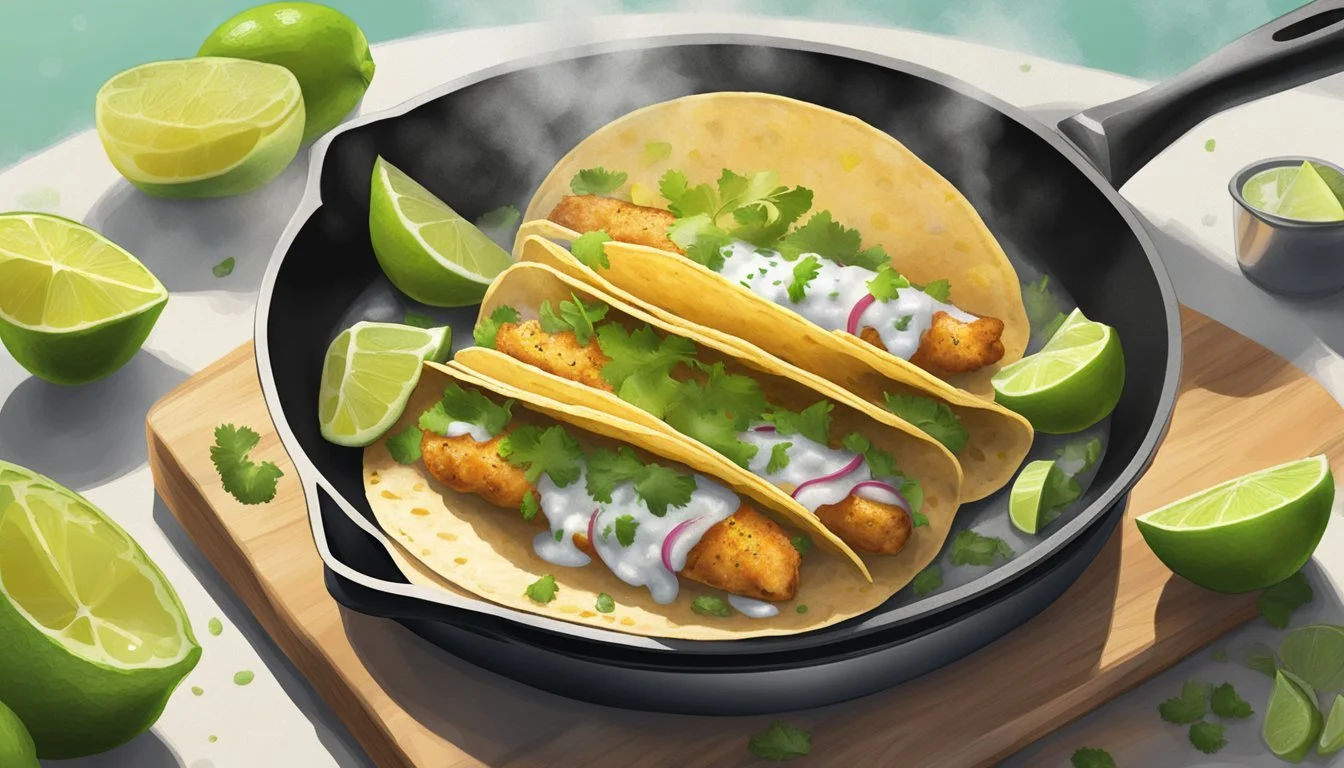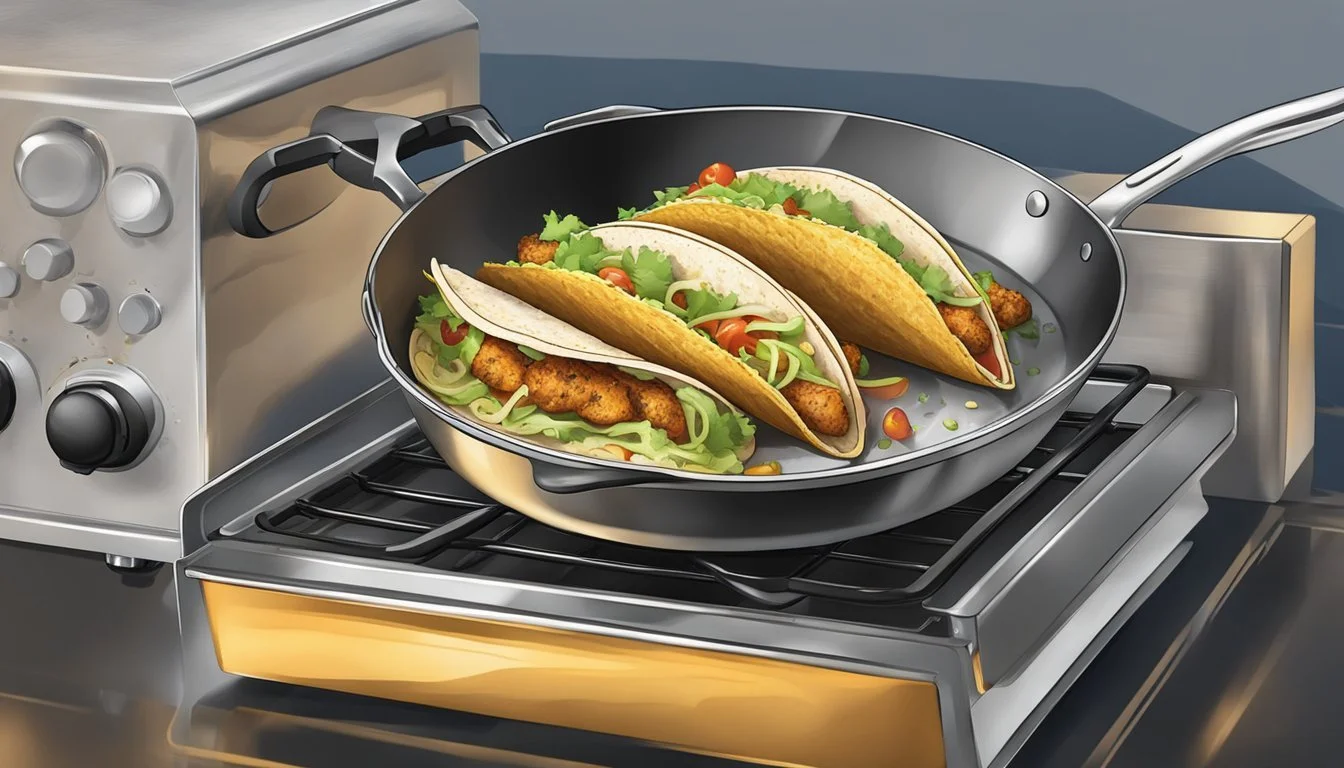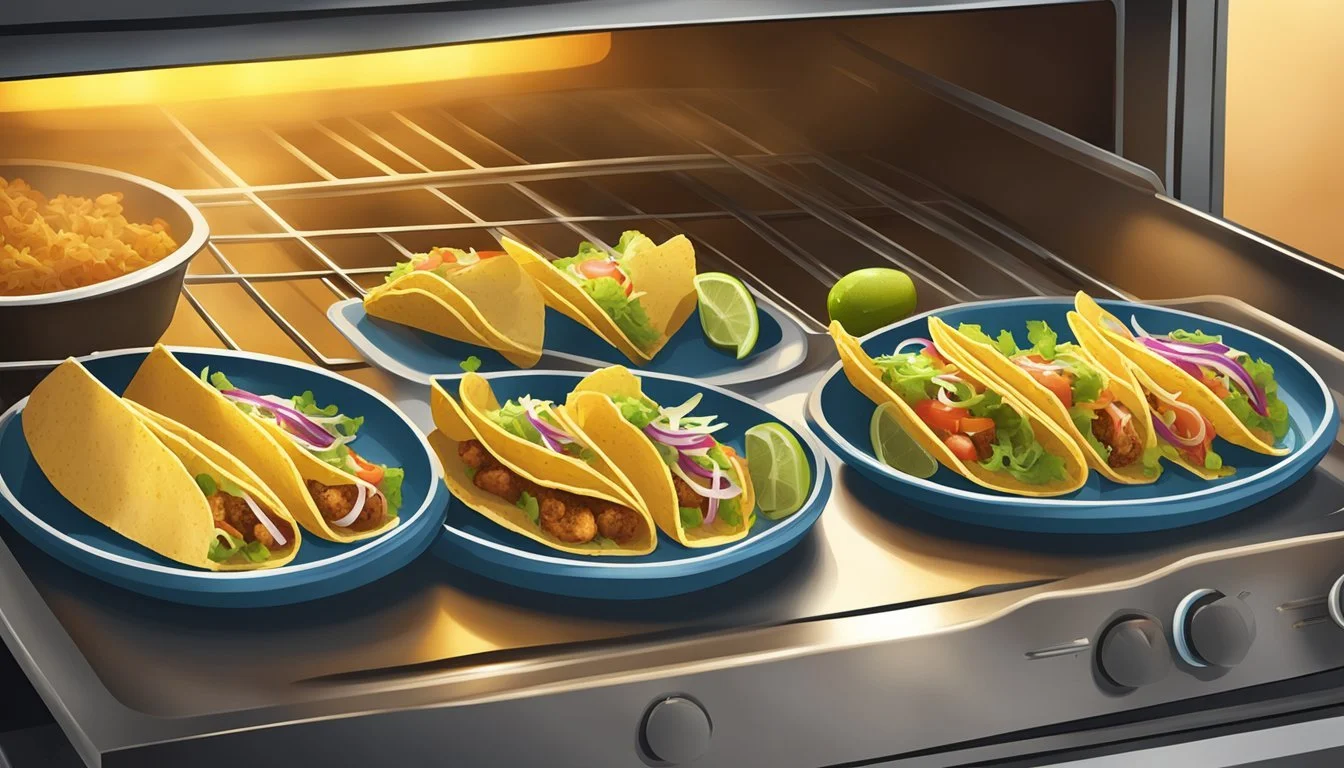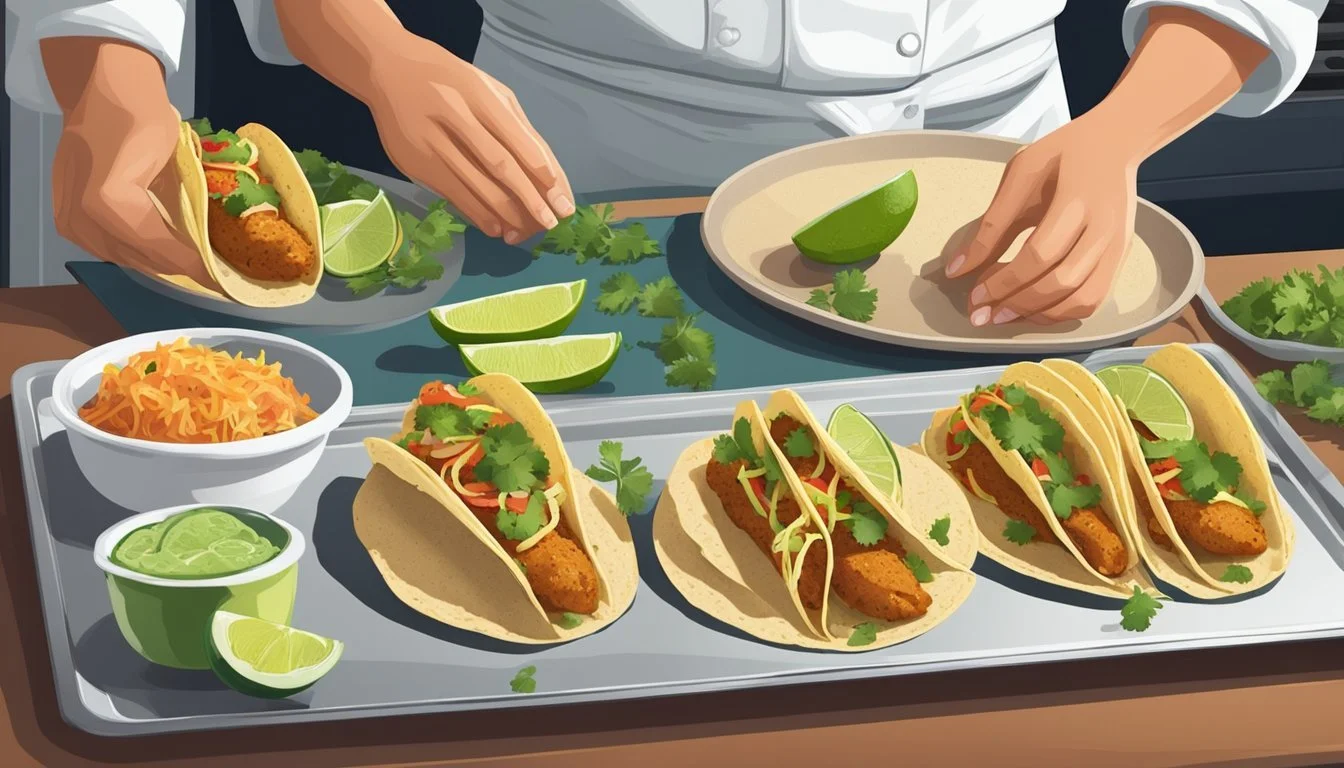Best Way to Reheat Fish Tacos
Crispy, Tasty, Perfect Warm-Up Method
Reheating fish (What wine goes well with fish?) tacos to retain their original crispy and flavorful quality requires a methodical approach. Fish tacos are a beloved dish known for their combination of textures and tastes, from the succulent fish to the crunchy coating and fresh toppings. Preserving these elements when reheating is essential for an enjoyable eating experience.
To achieve the best results, one must consider the components of fish tacos separately. The fish, typically coated in a crispy batter, needs to be handled differently than the soft tortillas. Proper reheating ensures that the fish's coating remains crisp and does not become soggy, while the tortillas regain their warmth without losing their texture. Using techniques that cater to the individual needs of each component, such as using an oven or skillet for the fish and a microwave with a glass of water for the tortillas, can bring fish tacos back to their freshly made state.
Understanding Fish Tacos
In this section, readers will gain insights into the origins, key components, and the various iterations of fish tacos that contribute to the unique taste and texture of this beloved Mexican dish.
History of Fish Tacos
Fish tacos are believed to have originated in Baja California, Mexico. They were created as a way to enjoy the plentiful local fish and reflect a mesh of Mexican and maritime flavors, becoming a staple in Mexican cuisine. Over time, they have gained popularity, particularly in Southern California, and have spread across the globe as a Mexico-inspired fast-casual food.
Essential Components of Fish Tacos
Fish tacos consist of a few critical elements that define their flavor profile:
Soft Taco Shells: Traditionally, corn tortillas are used, providing a firm yet flexible structure, while flour tortillas are favored for their softness and slight chewiness.
Fish: The star ingredient, typically a mild white fish like cod or tilapia, is often battered and fried, but can also be grilled for a lighter option.
Crispy Coating: A light, crispy batter ensures a delightful crunch contrasting with the tender fish.
Meat Filling: A succulent and perfectly cooked piece of fish serves as the protein-packed filling.
Cold Toppings: Fresh, cold toppings such as cabbage slaw, pico de gallo, sliced avocado, cheese, or sour cream add texture and coolness.
Different Types of Fish Tacos
Variations of fish tacos can generally be categorized by the preparation of the fish and the type of tortilla:
Battered and Fried Fish Tacos: Often served in soft corn tortillas, these tacos feature fish coated in a beer batter or seasoned breadcrumbs, deep-fried until golden brown.
Grilled Fish Tacos: A healthier alternative, where the fish is marinated, grilled, and typically served in soft tortillas, either corn or flour, depending on preference.
Hard-Shell Tacos: Less traditional and more Americanized, these tacos feature a crispy, fried tortilla shell holding the same tasty fish and toppings as their soft-shell counterparts.
Proper Storage Techniques
Proper storage is crucial for maintaining the freshness and preventing spoilage of leftover fish tacos. The reader will find out how to keep their tacos tasting great whether they plan to enjoy them the next day or save them for a longer period.
Storing in the Fridge
One should place their leftover fish tacos in the fridge within two hours of preparation to prevent bacterial growth. For optimal freshness, the fish and the taco shells should be stored separately. Fish can be kept in a tightly sealed container to avoid drying out, whereas taco shells will benefit from being stored in a breathable environment to maintain their crispness.
Airtight Containers for Freshness
Using airtight containers is the best practice to preserve the flavors of the leftover tacos. For the fillings, one can place them in separate airtight containers; this not only keeps them fresh but also prevents odor transfer within the fridge. If components like salsa or guacamole are involved, pressing a layer of plastic wrap directly on the surface before sealing the container can help prevent oxidation.
Freezing for Long-Term Preservation
If the leftovers are not intended to be consumed within a few days, freezing is a viable option for long-term storage. It is advisable to wrap the fish in cling film or aluminum foil and then place it into a zip-top freezer bag, squeezing out as much air as possible before sealing to prevent freezer burn. Taco shells can be wrapped in aluminum foil and placed in freezer bags separately. Notably, some ingredients like fresh vegetables or sauces may not freeze well, so it is best to freeze the core components only — typically the fish and the taco shells.
Reheating Fish Tacos
The key to successfully reheating fish tacos lies in retaining the original texture and flavor. Understanding suitable reheating methods and handy tips are essential for this process.
Preparing for Reheating
Before reheating fish tacos, it's important to separate cold toppings such as lettuce, cheese, and sour cream to prevent them from becoming soggy. The fish should be wrapped in aluminum foil, potentially with a light spread of olive oil or melted butter to preserve moisture.
Fish: Wrap in aluminum foil with oil/butter.
Toppings: Remove and set aside.
Choosing the Right Reheating Method
Several methods can reheat fish tacos effectively:
Microwave: For a rapid option, place taco shells in the microwave with a quarter glass of water to prevent them from drying out. Use the reheat setting for 20-60 seconds.
Oven: For crispiness, preheat the oven and place battered fish on a wire rack over a baking sheet at a moderate temperature.
Stove: Heat a non-stick pan with a little oil on medium heat and stir the fish occasionally.
Air Fryer: Preheat it to 350°F and heat the tacos for about 2-3 minutes, ensuring they are not overcrowded.
Oven Method: Retains crispiness, moderate heat, wire rack.
Stovetop Method: Medium heat, occasional stirring.
Air Fryer Method: 350°F, space around tacos, 2-3 minutes.
Reheating Tips for Optimal Flavor and Texture
For the best experience:
Microwave: Use sparingly, as it may affect the texture.
Oven: A moderate temperature prevents the fish from drying out while maintaining a crispy coating.
Stove: Constant attention ensures even reheating without overcooking.
Air Fryer: It's ideal for quick reheating while keeping shells crisp.
Moisture Control: Use foil and oil/butter for fish.
Timing: Pay close attention not to overheat and dry out the fish.
Key Reheating Methods
Reheating fish tacos while maintaining their taste and texture involves choosing the right method for the job. Different kitchen appliances can provide optimal results, ensuring that the tacos come out evenly warmed, with the fish keeping its intended flavor and the shells staying crisp.
Oven Reheating for Even Warmth
When utilizing an oven to reheat fish tacos, it's crucial to preheat it to 350°F (180°C). For soft-shell tacos, lightly dampen them with water or wrap them in slightly moist paper towels to prevent drying out. Position them on a baking sheet, ensuring they're not covered, to retain the texture. On the other hand, hard-shell tacos can be placed directly in the oven without any covering. The key is to heat them for about 5-7 minutes, for an even distribution of warmth without sogginess.
Stovetop Skillet for a Crispy Edge
The stovetop method involves using a skillet or non-stick pan. Heat the skillet on medium, adding a minimal amount of oil to lightly coat the bottom. The taco shells should be laid in the pan singularly to avoid crowding which allows for even heat distribution. For optimal crispness, reheat the tacos for 2-3 minutes on each side, flipping carefully to avoid breaking them. This method is particularly suited for achieving a crispy edge on hard-shell tacos.
Air Fryer for Quick Crispiness
Air fryers are adept at reinvigorating the crispiness of fish taco shells in a short period. Preheat the air fryer to about 350°F (180°C). Position the tacos in the air fryer basket, ensuring they aren't overlapping, for ideal heat circulation. The frying process should take just a few minutes, usually between 3-4 minutes. This will help to avoid the texture becoming rubbery or the shell losing its crunch.
Avoiding the Microwave for Fish Tacos
In contrast to other methods, using a microwave to reheat fish tacos is not recommended. Microwaves tend to disrupt the texture, often leading to a soggy outcome which can be unappealing for both the fish and taco shells. To preserve the quality of fish tacos, it is advisable to opt for the aforementioned methods that more effectively maintain the desirable texture and taste.
Additional Tips and Considerations
When reheating fish tacos, one's focus should be on maintaining the integrity of the dish's textures and flavors. Properly managing moisture levels and heat application is critical to ensure that the meal is as enjoyable as its first serving.
Maintaining Moisture and Crispiness
Fish tacos require a delicate balance between moisture to keep the fish tender and crispiness to maintain the shell's crunch. Introducing a small glass of water in the microwave when reheating can prevent the shell from drying out. Fish wrapped in aluminum foil with a touch of olive oil can retain moisture when warmed. For crispy results, reheating the fish on a wire rack in an oven ensures proper air circulation.
Handling Cold Ingredients and Toppings
Cold ingredients such as sour cream or fresh vegetables should be handled separately. They must remain cold and be added only after the hot components of the taco have been reheated. This not only preserves the texture and flavor of these components but also prevents any unwanted sogginess.
Avoiding Common Reheating Mistakes
To avoid common mistakes, one should:
Never reheat fish tacos with cold toppings already on them.
Avoid overpacking the skillet or dish when reheating to ensure even heat distribution.
Do not use high heat to reheat gluten-free taco shells, as this can cause them to burn or become too tough.
By adhering to these practices, one can enjoy leftover or even fast food fish tacos revitalized to their utmost potential.
Serving and Presentation
Proper serving and presentation are crucial in ensuring that reheated fish tacos offer a pleasing dining experience. Aesthetics play an essential role in how the meal is perceived, and a well-presented plate can enhance the overall enjoyment.
Enhancing Presentation After Reheating
Once the fish tacos are optimally reheated to maintain their crispiness and warmth, special attention should be given to the visual arrangement. For soft tacos, a warm tortilla can be the canvas, gently cupping the fish, allowing for a semi-open presentation that showcases the filling. Hard tacos, on the other hand, should stand upright with fillings layered visibly.
Drizzle of sour cream in a zigzag pattern over the top can add a visual and flavorful zing.
A final garnish of fresh herbs such as cilantro can bring vibrant color and freshness, counterbalancing the warmth of the reheated components.
Pairing with Sides and Condiments
Fish tacos pair wonderfully with a variety of sides and condiments, which should be chosen to complement the main dish without overpowering its flavors.
Diced tomatoes
Shredded lettuce
Chopped onions
Fresh cilantro
Sliced avocado
These items should be served on the side or layered carefully on the fish tacos after reheating to maintain their freshness and crunch.
Condiment options:
Sour cream - serves as a cooling agent
Salsa or hot sauces - ranges can vary from mild to extra spicy, adjusted to taste
Lime wedges - a squeeze adds a refreshing acidity, brightening the flavors
Whether serving soft or hard tacos, or even a hybrid like quesadillas, each side and condiment should be presented in separate bowls or on a platter with serving utensils to allow diners to customize their meal to their liking.
FAQs
In this section, readers will find answers to commonly asked questions regarding the effective reheating of fish tacos to maintain their crispiness and flavor.
Common Questions about Reheating Fish Tacos
Q: How can one reheat fish tacos to keep the shell crispy?
A: To keep the shell of a taco crispy, it's best to heat it separately from the filling. For hard shells, heating them in a preheated oven at 350°F or in an air fryer set at 350°F for 2-3 minutes works well. For soft shells, wrapping them in slightly damp paper towels before placing them in the oven can preserve their texture.
Q: What is the recommended method to reheat taco meat without drying it out?
A: The taco meat should be reheated gently on the stove with a little oil in a non-stick pan over medium heat. Stir occasionally until it's heated through, which ensures the meat remains moist.
Q: Is it possible to reheat tacos from fast-food restaurants like Taco Bell effectively?
A: Yes, tacos from establishments like Taco Bell can be reheated. One should deconstruct the tacos by removing cold toppings first. Heat the shells and meat as advised above, and then reassemble the tacos with the fresh toppings before serving.
Q: Can fish from leftover tacos be reheated without it becoming rubbery?
A: To avoid fish from leftover tacos becoming rubbery, one should wrap the fish in aluminum foil with a bit of olive oil or butter and reheat it in the oven or microwave using a low heat setting. Quick reheating is key to maintain the fish's texture.
Q: What is the best way to reheat homemade tacos that have both fish and vegetables?
A: For homemade tacos with fish and vegetables, it's best to reheat components separately to preserve their individual textures. Vegetables can be sautéed quickly on the stove, while fish can be reheated in foil as described previously.
Q: Is using a grill an effective method for reheating tacos?
A: Using a grill can be effective for reheating the taco shells but may not be suitable for the fish, as it can cause it to dry out. A grill provides a nice char to hard taco shells, but one must monitor closely to avoid burning.
Q: Can a deep fryer be used to reheat fish tacos?
A: A deep fryer is generally not recommended for reheating fish tacos as it can make the tacos excessively greasy and alter their texture unfavorably. Other methods like the oven or air fryer are better suited for reheating fish tacos.






